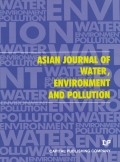Authors: Qiu, Shengnu | Snegirev, Dmitry | Domatskiy, Vladimir | Gura, Dmitry | Fedotov, Nikita
Article Type:
Research Article
Abstract:
Microbiological methods for identifying the status of water in modified anthropogenic zones are the most accurate techniques that reflect the actual condition of water bodies. This work aims to perform a comparative analysis of hydrochemical and microbiological indicators in 20 small rivers of the Surgutsky and Oktyabrsky districts of Khanty-Mansi Autonomous Okrug of the Russian Federation. The research was conducted in 2018-2019 in Surgutsky and Oktyabrsky districts using water samples collected in spring, summer and autumn from 20 small rivers. The neutral and mildly alkaline values of pH were the highest in summer (7.6). Maximum ammonium ion concentrations of up
…to 0.5 mg per 1 dm3 were registered during spring when the snow was melting. No differences in total microbial accounts between 2018 and 2019 were noted in the Surgutsky district (p ≥ 0.05). However, there were differences between rivers. Thus, rivers No. 4, 5, and 7-10 accounted for the minimum in both years (microbial count is 101 -102 ), while rivers No. 1-3 had 10-12 times higher microbial count (p ≤ 0.001, 103 ). For river No. 6, the values were 4 times higher compared with rivers No. 1-3 (p ≤ 0.01, 104 ) and 30-40 times higher compared with rivers No. 4, 5, and 7-10 (p ≤ 0.0001, 101-2 versus 104 ). The pollution in 2018-2019 can be considered constant. Rivers No. 18 and 19 in the Oktyabrsky region were the most contaminated, with microbial accounts 5 to 10 times higher than others (p ≤ 0.001, 102-5 versus 101 ). River No. 12, with a microbial count of 2-5 thousand per 1 ml in 2018, reached 42-45 thousand per 1 ml in 2019 (p ≤ 0.001), a value higher than in the constantly polluted rivers No. 18-19 (p ≤ 0.05 with 2019). Microflora was consistent during the two-year study. It is explained by the fact that the number of bacteria is determined by water temperature, indicators of dissolved O2 concentration, and indicators of organic compound concentration. The cluster analysis revealed 16 genera of bacteria and 3 mold fungi in the waters of 20 rivers studied. The Oktyabrsky district has the most significant number of very polluted rivers, whereas there are a lot of relatively clean rivers. The Surgutsky district is characterized by very clean rivers, along with moderately polluted rivers. Compared with the Oktyabrsky district, the rivers in the Surgutskydistrict are cleaner in microbiology because of lower anthropogenic pressure. Bacterial contamination can be reduced if the release of organic matter to waste water is lower, thereby substantially reducing the role of ammonifying bacteria in the microbiome.
Show more
Keywords: Bacterial pollution, microflora, small rivers, total microbial count
DOI: 10.3233/AJW220056
Citation: Asian Journal of Water, Environment and Pollution,
vol. 19, no. 4, pp. 55-61, 2022
Price: EUR 27.50





